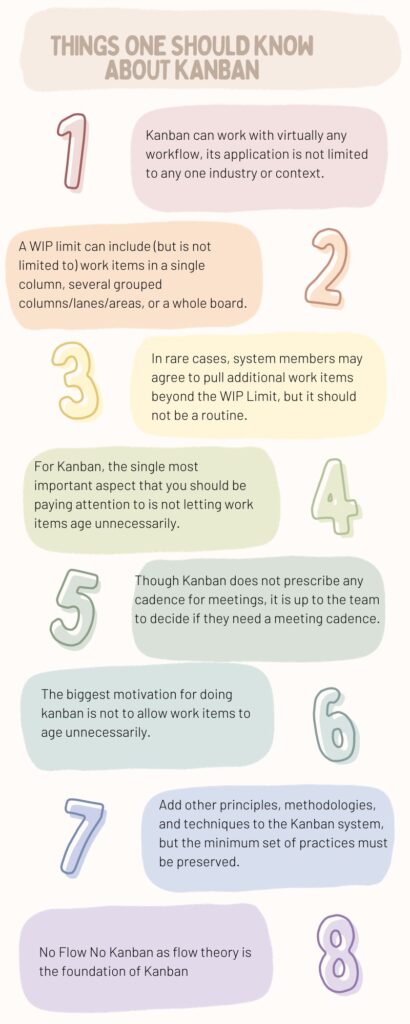14 Key Terms in Kanban – Everybody should know
Here are the terms that one comes across in Kanban. Understanding the concepts of these terms will help one in understanding Kanban.
Flow – Kanban is based on the theory of flow. Flow is of no use without value, in Kanban Flow is the movement of potential value through a system.
Kanban Practices – There are 3 practices in Kanban ( (1) Defining and visualizing a workflow (2) Actively managing items in a workflow (3) Improving a workflow
Kanban system – Kanban practices are collectively called a Kanban system
Kanban system members -Those who participate in the value delivery of a Kanban system are called Kanban system members.
Workflow – How work gets done + movement of potential value through a system.
Definition of Workflow (DoW) – This is the fundamental concept of Kanban. The explicit shared understanding of flow among Kanban system members within their context is called a Definition of Workflow (DoW).
Kanban Board – The visualization of the Definition of Workflow (DoW)is called a Kanban board.
Work Items – A definition of the individual units of value that are moving through the workflow.
Work in progress (WIP) – Any work items between a started point and a finished point are considered work in progress (WIP).
WIP limits – WIP stands for Work in Progress, part of actively managing items on a workflow practice. Controlling WIP helps in managing the workflow which means not adding new work items unless the in-progress work items are completed.
Service Level Expectation (SLE) – Forecast of how long it should take a work item to flow from start to finish. It serves 3 functions – right sizing, completion forecast, and how much age is too much age.
Throughput: The number of work items finished per unit of time. Note the measurement of throughput is the exact count of work items.
Work Item Age: The amount of elapsed time between when a work item started and the current time.
Cycle Time: The amount of elapsed time between when a work item started and when a work item finished.
Refer this page – Kanban on a page to know about Kanban in a nutshell.
What is Kanban in agile?
Closely connected to Lean, Kanban is the lightest of the Agile frameworks. It is an incremental, evolutionary change for technology development/operations organizations. Kanban is all about visualizing the work, limiting work in progress, and maximizing flow.
Origin of Kanban
Kanban is not a new concept; it has been used by the manufacturing units since 1940. Toyota, the famous car company in Japan developed Kanban to improve manufacturing efficiency. It is a scheduling system built for Just in Time manufacturing.
Based on this concept, Kanban was adopted by the knowledge work organizations. In 2011, David J. Anderson framed the Kanban method as a method to incremental, evolutionary process.
4 principles of Kanban –
- Start with what you do now
- Agree to pursue incremental, evolutionary change
- Respect the current process, roles, responsibilities & titles
- Encourage acts of leadership at all levels in your organization
6 practices of Kanban –
- Visualize (the work, workflow and business risks)
- Limit WIP
- Manage Flow
- Make Process Explicit
- Implement Feedback Loops
- Improve Collaboratively, Evolve Experimentally (using models & the scientific method)


